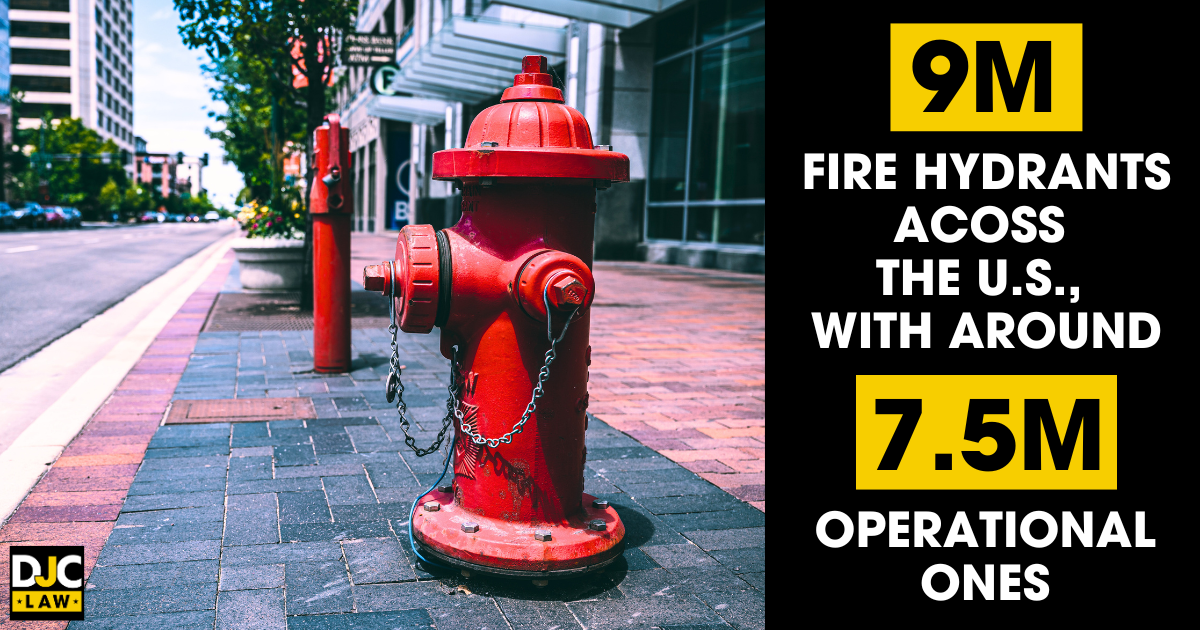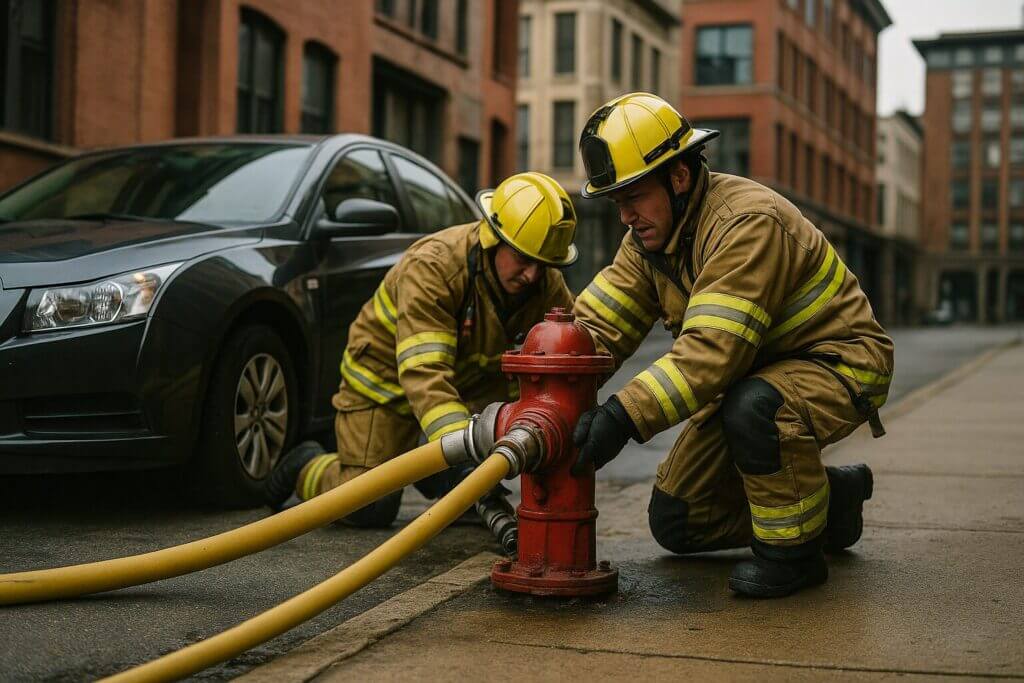
Fire safety might not be the first thing you think of when you’re driving your way to work, but it’s essential. Parking in front of a hydrant impedes fire suppression efforts and potentially means the fire service must damage your vehicle to gain access to the nearest hydrant.
According to Verisk Insurance, there are around nine million fire hydrants across the U.S., with around 7.5 million operational ones. Parking in front of any of them could be breaking the law where you live.
Like so many things, no federal law exists on fire hydrants and parking, thus leaving it up to the states. If you've been involved in an accident related to illegal parking or roadway hazards, consider consulting an Austin car accident lawyer to understand your legal options. Today, we’ll go through everything drivers must know when encountering a fire hydrant.

Key Takeaways
- Parking in front of or too close to a fire hydrant is illegal in all states because fire engines require easy access to hydrants in an emergency.
- The general rule of thumb is to park at least 15 feet away from hydrants, which covers all states.
- Each state may determine its own fire hydrant parking restrictions, with states like Vermont allowing you to park as close as six feet to a hydrant.
- Some exceptions exist for parking near fire hydrants, such as if you’re an emergency service vehicle, experiencing an emergency, or making a brief stop to pick up passengers.
- Penalties for parking too close to a fire hydrant include fines, the risk of getting your vehicle towed, and damage to your vehicle if emergency services must access a hydrant.
- You could be liable for damages or accidents because you blocked access to a fire hydrant.
- Speak to an attorney if you were involved in an accident close to a fire hydrant to ensure that your legal rights are respected and at-fault parties are held to account.
How Close to a Fire Hydrant Can You Legally Park?
The general rule of thumb is that you shouldn’t park within 15 feet of a fire hydrant for safety reasons. Most states follow the 15-foot rule, which is why it’s the rule to live by, but some states allow you to park even closer.
For example, Iowa state law allows you to park within five feet of a hydrant without breaking the law. Vermont allows you to park within six feet.
State-by-State Overview of Parking Regulations
| State | Distance |
|---|---|
| Alabama | 15 feet |
| Alaska | 15 feet |
| Arizona | 15 feet |
| Arkansas | 15 feet |
| California | 15 feet |
| Colorado | 15 feet |
| Connecticut | 10 feet |
| Delaware | 15 feet |
| District of Columbia | 10 feet |
| Florida | 15 feet |
| Georgia | 15 feet |
| Hawaii | 15 feet |
| Idaho | 15 feet |
| Illinois | 15 feet |
| Indiana | 15 feet |
| Iowa | 5 feet |
| Kansas | 15 feet |
| Kentucky | 15 feet |
| Louisiana | 15 feet |
| Maine | 10 feet |
| Maryland | 15 feet |
| Massachusetts | 10 feet |
| Michigan | 15 feet |
| Minnesota | 10 feet |
| Mississippi | 10 feet |
| Missouri | 15 feet |
| Montana | 15 feet |
| Nebraska | 15 feet |
| Nevada | 15 feet |
| New Hampshire | 15 feet |
| New Jersey | 10 feet |
| New Mexico | 15 feet |
| New York | 15 feet |
| North Carolina | 15 feet |
| North Dakota | 10 feet |
| Ohio | 15 feet |
| Oklahoma | 15 feet |
| Oregon | 10 feet |
| Pennsylvania | 15 feet |
| Rhode Island | 8 feet |
| South Carolina | 15 feet |
| South Dakota | 15 feet |
| Tennessee | 7.5 feet |
| Texas | 15 feet |
| Utah | 15 feet |
| Vermont | 6 feet |
| Virginia | 15 feet |
| Washington | 15 feet |
| West Virginia | 15 feet |
| Wisconsin | 10 feet |
| Wyoming | 15 feet |
General Distance Requirements from Fire Hydrants
The National Fire Protection Association (NFPA) recommends not parking a vehicle within 15 feet of any nearby fire hydrants. Additionally, there should be at least three feet of clear space around the circumference of each fire hydrant.
Why is the 15-foot the standard recommendation? Simply put, it’s the distance that would enable you to park legally in all 50 states. No state’s minimum distance requirement is above 15 feet.
How far is 15 feet from a fire hydrant really?
Fifteen feet, or 4.5 meters, represents the length of a large SUV or if you lay three adult bicycles down end to end. It’s the most straightforward way to remember it without measuring the specific distance.
The Importance of Keeping Clear of Fire Hydrants
Blocking fire hydrants prevents fire departments from doing their jobs. Emergency service personnel rely on the nation’s network of operational fire hydrants for a constant stream of water to put out fires and save lives.
Fires spread faster than most people think, and every minute lost due to an obstruction could mean another building catching fire or someone unnecessarily losing their life. According to the Western Fire Chiefs Association, wildfires spread at an average rate of 14.23 miles per hour.
Safety Concerns for Emergency Services
Emergency services rely on fire hydrants to quickly extinguish fires. Drivers who park in front of hydrants don’t just block hydrants but also obscure visibility, meaning firefighters may be unable to locate a hydrant at short notice.
Additionally, parking too close limits how much space emergency vehicles have to work with. Personnel must open valve stems, connect and deploy hoses, and then maneuver around hydrants to do their jobs.
Impact on Fire Response Times
Inconsiderate drivers cause a considerable delay in fire response times, with lives being lost because fire crews didn’t have enough space to operate their equipment or they didn’t see it on the sidewalk in the first place.
In many parts of the US, the problem has been getting worse. For example, the New York Post reported that the number of calls relating to blocked hydrants increased from 11,886 in 2014 to 64,346 in 2020.

Why is it Dangerous to Park Next to a Fire Hydrant?
Parking next to a fire hydrant is dangerous for people for fire crews who may lose their access to an immediate water supply, thus making fires worse. This has a knock-on impact, where fire crews cannot save the lives of those who might be caught up in a fire.
Exceptions and Special Circumstances
Parking restrictions around fire hydrants exist to protect your community, but there are some exceptions to the rules, such as for temporary stops or if you’ve got a special permit. Some states also have seasonal adjustments, such as if heavy snow buries hydrants, and event-related exceptions.
Note that any exceptions or special scenarios exist at the behest of your state government and potentially even your municipality.
A Typical Situation: Who Qualifies for Parking Exceptions?
Parking exceptions are strictly controlled to protect the public. The most common exception is emergency service vehicles.
For example, a police officer pursuing a criminal would be entitled to park in front of a hydrant. Likewise, an ambulance responding to a medical emergency would be permitted to park in front of a hydrant.
The most common situation applying to the average person is temporary stopping. Some jurisdictions allow you to stop to drop off or pick up passengers. Where these exceptions exist, you’re nearly always required to stay with the vehicle so that it can be quickly moved.
Variations in Regulations for Different Types of Vehicles
Exceptions to fire hydrant parking rules often pertain to different types of vehicles. Typically, these are vehicles used by emergency services in the course of their duties, but different states may have other exceptions.
For example, Texas law Transportation Code 545.302 allows private vehicles to be parked in front of hydrants if they’re operated by elevator constructors responding to an elevator-related emergency.
Best Practices for Parking Near Fire Hydrants
The best practice is to avoid standing anywhere near fire hydrants so that you are on the safe side. However, this might not be possible with on-street parking often being unavailable. If you spot a hydrant, adopt a cautious approach, and don’t be afraid to find an alternate parking solution if you’re unsure.
Follow these best practices if you’re forced to park close to a hydrant:
- Search for Hydrant Markings – Many hydrants, especially those in downtown areas, are marked with either signage or road markings. Many cities have curbs painted red or yellow to show where you shouldn’t park.
- Estimate the Safe Distance – Struggling to work out whether you’re too close? The easiest way to estimate is to leave at least a standard car length between you and the hydrant.
- Act Cautiously – Enforcement in urban areas tends to be much stricter than anywhere else due to the elevated risk of fires. Use some basic commonsense, even if it means parking further away than intended.
- Check Local Laws – Don’t rely exclusively on state law as your north star. Every municipality can issue ordinances that make parking restrictions stricter. Double-check local regulations if you’re in an unfamiliar state or city.
Using Technology to Avoid Fire Hydrant Violations
Drivers frustrated by hydrants and on-street parking can also use technology to avoid violations. Like everything else, there’s an app for that. Many cities now have widely available apps that tell drivers where parking restrictions are in place, including the location of operational fire hydrants.

Fire Hydrant Parking and Car Accidents: Legal Consequences
Parking in front of or too close to a fire hydrant is an offense. You could face fines and your vehicle being towed. The latter could add up to hundreds of dollars, especially if you don’t reclaim your vehicle quickly.
Each city and state sets its own penalties. For example, Texas cities have a wide variation in standard fines:
- El Paso - $55
- Austin - $70
- Houston - $105
It’s also vital to mention that accidents involving fire hydrants could result in extra legal consequences. Some cities have tacked on additional damages for drivers who damage hydrants.
For example, Asuza, California, charges various statutory fees, including:
- Fire Hydrant Inspection Fee
- Fire Hydrant Relocation Impact Fee
- Traffic Incident Hit Hydrant Impact Fee
All these costs could apply to you, with each charge amounting to $2,500 each for a total of $7,500.
Who is Liable if You Hit a Fire Hydrant?
Hitting a fire hydrant means you’ll face liability because it’s damage to city property. Generally, you’ll be held accountable for the repair costs of the fire hydrant and any other nearby damage caused by the accident.
Some exceptions exist. For example, if another driver sideswiped you and your vehicle was forced into the hydrant, liability might fall on the other driver if you had no contribution to the accident.
Can You Be Sued for Damages After Hitting a Fire Hydrant?
You may be sued for damages if you hit a fire hydrant. The city is entitled to file a lawsuit against you for damages caused. Another problem is that if you damage a fire hydrant and fire crews can’t access water, thus leading to more damage, you could be held liable.
The issue is that if you render a hydrant non-functional and someone sustains injuries or dies because fire crews are delayed in addressing the emergency, you will be held responsible.
Does Insurance Cover Fire Hydrant Collision Damages?
Fire hydrants are considered city property, so any damage caused will be covered under your liability coverage. If you possess liability coverage, it covers the damage to the hydrant but not to your own vehicle.
That’s why it’s wise to have collision coverage because it will cover the cost of the damage to the hydrant and any damage to your vehicle.
Car Accidents Near Fire Hydrants: Legal Implications
Car accidents near fire hydrants can also have significant legal implications, such as if an accident damages the hydrant or obstructs fire crews during their duties. Understanding the various scenarios helps you assess your legal options if you get into an accident close to one of these installations.
What Happens if a Parked Car Near a Fire Hydrant Causes an Accident?
Drivers who park close to fire hydrants are breaking the law, meaning they will assume liability if someone crashes into their vehicle, including emergency services personnel, since they weren’t supposed to be there in the first place.
Of course, Texas’ shared fault laws mean it’s not always as clear-cut as that. For example, if an intoxicated driver hits your parked car, you won’t be assigned sole liability for the accident because the other driver also broke the law. In scenarios like this, liability will be shared, which impacts the size of any potential settlement award.
Can You Fight a Ticket for Parking Near a Fire Hydrant After an Accident?
It’s possible to fight a ticket for parking near a fire hydrant after an accident, but it’s an uphill battle you’re unlikely to win. The law is clear on parking restrictions regarding fire hydrants, so it’s challenging to come up with a legal defense that a court will accept.
Legal Defenses for Fire Hydrant Parking Violations After a Crash
Few legal defenses exist for violating fire hydrant parking restrictions. Unless a special exception or circumstance applies, you’re unlikely to successfully fight a ticket or eliminate liability for the accident.
Some examples that could get your ticket removed include:
- Valid Exemption – If you have an exemption, such as if you’re driving an emergency services vehicle, this means you’re not breaking the law, so violating parking restrictions can’t be used against you.
- Emergency Situation – Emergencies outside of your control happen. For example, your engine might have blown up, and you happened to have come to a halt next to a fire hydrant. Courts may recognize that you didn’t have a choice in the matter, so there’s mitigation.
- Visibility – Texas is known for its heavy snow. Some parts of the state receive heavy snowfalls that might bury hydrants and obscure road markings. If you can prove it, you could argue that there was no visible indication that a hydrant was present and parking restrictions were in place.
Can Emergency Responders Damage Your Car If You Block a Fire Hydrant?
Emergency responders have the legal right to move or damage vehicles to access a fire hydrant in an emergency within reason.
For example, fire crews could smash your windows to connect hose lines through your vehicle. They could also release your handbrake to move your vehicle from the scene or even shunt your car out of the way.
What to Do if You Hit a Fire Hydrant in an Accident?
Hitting a fire hydrant is classified as a car accident, meaning you’re legally obligated to report the crash to the relevant authorities, or it’s classified as a hit-and-run offense. In this case, you must notify your city authorities because fire hydrants are the property of the city.
Follow these steps if you hit a hydrant:
- Stop – The first step is to stop and report the accident. Call 911 and ask for an ambulance if anyone is seriously injured, and call the relevant number for your city’s authorities to report the crash. Each city may have different reporting protocols. You should also ask for a traffic officer to attend.
- Gather Evidence – Use your smartphone to take photos of the accident. Focus on the damage to the hydrant, any other property, and damage to your vehicle. Also, snap some photos if you have any visible injuries. If there were any eyewitnesses, ask if they’d be willing to supply their contact details and provide a statement.
- Wait – Exchange insurance and contact details with any other parties that may have been involved.
- Seek Medical Attention – Visit your nearest medical facility for an examination. You may feel okay, but some hidden injuries take hours or days to show symptoms, such as whiplash, concussion, and internal injuries.
- Report – Report the accident to your insurer. Even if the damage isn’t significant, you’re required to report every accident, which could invalidate your auto insurance policy.
How a Car Accident Lawyer Can Help After a Fire Hydrant Incident?
Contact an Austin personal injury lawyer at the earliest opportunity to ensure that your legal rights are protected and you know your options. Car accident attorneys do more than file legal paperwork. Some of their functions include:
- Gathering evidence
- Building your case
- Proving liability
- Negotiating with insurance adjusters
- Dealing with city authorities
- Filing personal injury lawsuits
- Providing objective advice related to your case.
If you’ve been involved in an accident involving a fire hydrant, get in touch with DJC Law. We’re Austin’s premier law firm with a 99% case success rate and more than $400 million in settlement money won. To learn more, get your free consultation today.


